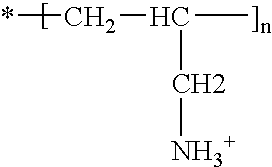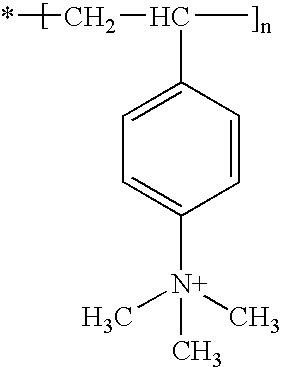Single-dip process for achieving a layer-by-layer-like coating
- Summary
- Abstract
- Description
- Claims
- Application Information
AI Technical Summary
Benefits of technology
Problems solved by technology
Method used
Image
Examples
example 1
[0172]The ability of polyionic materials to be coated onto a contact lens using layer-by-layer dipping was demonstrated. The substrate material (i.e. contact lens) was prepared with materials such as described in U.S. Pat. No. 5,760,100 to Nicolson et al.
[0173]A sample contact lens was initially coated with a primer layer by dipping the lens into a PEI solution for 5 minutes. The PEI solution was prepared by dissolving PEI powder in water such that a 0.001 M PEI solution resulted. After dipping, the lens was rinsed for 2 minutes in consecutive rinse baths. Once the above steps were completed, the lens was then dipped into a PAA solution for 5 minutes, rinsed for 2 minutes, rinsed for 2 minutes, dipped into a PAH solution for 5 minutes, rinsed for 2 minutes, rinsed for 2 minutes, dipped into a PAA solution for 5 minutes, etc., until 10 bilayers of polyionic material were formed onto the lens. The PAA and PAH solutions were prepared by dissolving the respective powders in water to for...
example 2
[0174]The ability of polyionic materials to be coated onto a contact lens using layer-by-layer dipping and air drying was demonstrated. The substrate material (i.e. contact lens) was prepared with materials, such as described in U.S. Pat. No. 5,760,100 to Nicolson et al.
[0175]A sample contact lens was initially coated with a primer layer by dipping the lens into a PEI solution for 5 minutes. The PEI solution was prepared by as described in Example 1. After dipping, the lens was dried for 1 minute with an air knife. Once the above steps were completed, the lens was then dipped into a PAA solution for 5 minutes, dried with an air knife for 1 minute, dipped into a PAH solution for 5 minutes, dried for 1 minute, dipped into a PAA solution for 5 minutes, etc., until 10 bilayers of polyionic material were formed onto the lens. The PM and PAH solutions were prepared as described in Example 1.
[0176]It was determined that 20 dipping steps, taking 120 minutes, were required to form a 100 to 2...
example 3
[0177]The ability of polyionic materials to be coated onto a contact lens using layer-by-layer spraying and air drying was demonstrated. The substrate material (i.e. contact lens) was prepared with materials, such as described in U.S. Pat. No. 5,760,100 to Nicolson et al.
[0178]A sample contact lens was initially coated with a primer layer by spraying a PEI solution onto the lens for 1 minute using an ultrasonic nozzle. The PEI solution was prepared as described in Example 1. After spraying, the lens was dried for 1 minute with an air knife. Once the above steps were completed, the lens was again sprayed with a PAA solution for 1 minute, dried for 1 minute, sprayed with a PAH solution for 1 minute, dried for 1 minute, sprayed with a PAA solution for 1 minute, etc., until 10 bilayers of polyionic material were formed onto the lens. The PAA and PAH solutions were prepared as described in Example 1.
[0179]It was determined that 20 spray steps, taking 40 minutes, were required to form a 2...
PUM
| Property | Measurement | Unit |
|---|---|---|
| Thickness | aaaaa | aaaaa |
| Antimicrobial properties | aaaaa | aaaaa |
Abstract
Description
Claims
Application Information
 Login to View More
Login to View More - R&D
- Intellectual Property
- Life Sciences
- Materials
- Tech Scout
- Unparalleled Data Quality
- Higher Quality Content
- 60% Fewer Hallucinations
Browse by: Latest US Patents, China's latest patents, Technical Efficacy Thesaurus, Application Domain, Technology Topic, Popular Technical Reports.
© 2025 PatSnap. All rights reserved.Legal|Privacy policy|Modern Slavery Act Transparency Statement|Sitemap|About US| Contact US: help@patsnap.com



